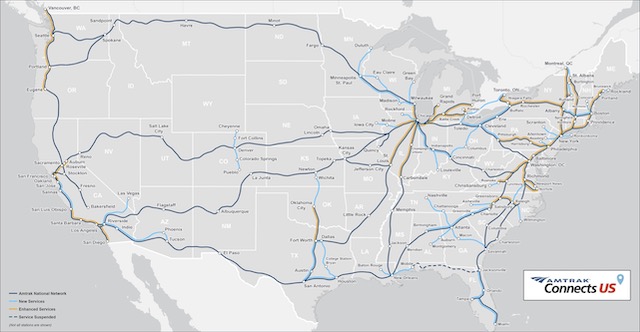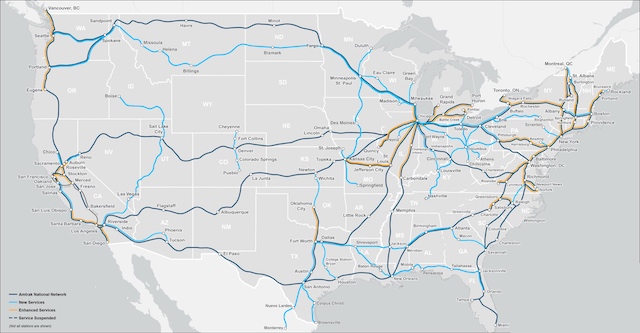Matthew Yglesias thinks that Amtrak’s latest “vision” is “slow and boring” and that Amtrak instead should spend money on high-speed trains in the Boston-Washington corridor. But Yglesias’ vision is no better; it might be faster, but it also means faster spending of money on worthless projects.
Amtrak’s 2021 “vision” for expanding its rail service. Click image for a larger view.
The first thing to note is that Amtrak’s latest plan is not so much a vision as it is a smorgasbord of pork barrel. Amtrak told the states, “We have this free federal money to spend; if you want some of it, draw some lines on a map where there are rail lines and maybe we’ll spend it there.” What Yglesias calls a vision is a taxpayers’ nightmare of idiotic rail projects.
A transportation planner named Ryan Colburn made this map of the corridors where states expressed an interest in getting federal money for passenger trains. Click image for a larger view.
Before Congress passed the infrastructure bill, Amtrak presented its tentative proposal to start passenger train service in such vital rail corridors as Brunswick to Rockland, Maine; Cheyenne, Wyoming to Pueblo, Colorado; Oklahoma City to Newton, Kansas; and Roanoke to Christiansburg, Virginia. This was “tentative” because, even if Congress passed the infrastructure bill, Amtrak would only offer these services if states agreed to subsidize their operating costs.
Amtrak’s 2022 “corridors of interest,” that is, corridors where states were interested in getting free federal money, include many even more ridiculous routes, including Boise to Salt Lake City; Columbus to Athens, Ohio; Fargo to Sand Point, Idaho; and Laredo, Texas to Monterrey, Mexico (is the state of Nuevo León going to subsidize that?). Of course, Amtrak hasn’t yet told any of the states how much they will be expected to cough up to keep such trains running, but even when it does the states plan to just pass the bill onto non-train-riding taxpayers.
I agree with Yglesias that these are stupid ideas, and he is even partly right about why they are stupid: rail routes are one-dimensional lines, yet we live in two-dimensional landscapes that aren’t well served by one-dimensional transportation systems. Amtrak’s current 21,000 mile route system doesn’t come close to providing the service that is derived from the nation’s 4 million miles of highways, roads, and streets, and adding a few thousand miles to Amtrak’s routes isn’t going to make any difference.
Unfortunately, Yglesias missed the other reason why Amtrak is stupid: passenger trains are really, really expensive compared with highway modes or airlines. For example, in 2019, which Amtrak claimed was financially the best year in its history, the state-owned company collected an average of 37.5¢ per passenger-mile from passengers and spent another 35.6¢ per passenger-mile subsidizing those passengers for a total cost of more than 73¢ per passenger-mile.
By comparison, air fares plus subsidies to airlines averaged under 20¢ per passenger-mile and spending on automobiles plus highway subsidies averaged 26¢ per passenger-mile. Bus fares and subsidies are even lower than the airlines. Over just about any route for trips of any length, Amtrak costs more than any of the available alternatives.
Amtrak’s numbers were much worse in 2022, of course. According to its Fiscal Year report, fares averaged 37.2¢ per passenger-mile while subsidies leaped to 58.2¢ per passenger-mile, bringing total costs to more than 95¢ per passenger-mile.
As an alternative to Amtrak’s “corridors of interest,” Yglesias thinks Amtrak should put all of its spare cash into turning the Boston-to-Washington corridor into a true high-speed train system. This shows that he clearly missed the point of the high cost of passenger trains, as high-speed trains take those high costs to another level.
Amtrak’s latest “vision” for the Northeast Corridor called for spending $151 billion on that corridor, which the company promised would allow trains to run at 220 miles per hour. But that vision is from 2012 and costs have significantly risen since then.
For example, the Gateway project to rehabilitate bridges and tunnels entering New York City was projected to cost $14.7 billion in the 2012 plan. Today, that cost has risen to $30 billion. Of the $151 billion in Amtrak’s Northeast Corridor vision, $33.5 billion was aimed solely at restoring the existing infrastructure after years of neglect, so that cost is probably closer to $70 billion today. The infrastructure bill gave Amtrak less than $80 billion, so even if it put all of that money into the Northeast Corridor, it would not end up with significantly faster trains.
Yglesias points to Paris-Lyon as an example of a successful high-speed train. Supposedly, this train makes money, but I haven’t seen any proof of that. What I have seen is that France is outlawing competing flights in this corridor. If the trains are so successful, then why does the country need to ban the competition? The reality is that the trains are owned by the government and the airlines are private so the government is simply biased towards its own operations.
Yglesias should have replaced “slow and boring” with “slow, boring, and expensive.” If he had done so, he wouldn’t have made the mistake of thinking that higher-speed, highest-cost trains made any more sense than conventional high-cost trains.










Word that doesn’t appear in Yglesias’ piece: Dollars.
Word that appears once: Cost. ” … so the cost wouldn’t be enormous.”
A work of fiction — more fiction than work.